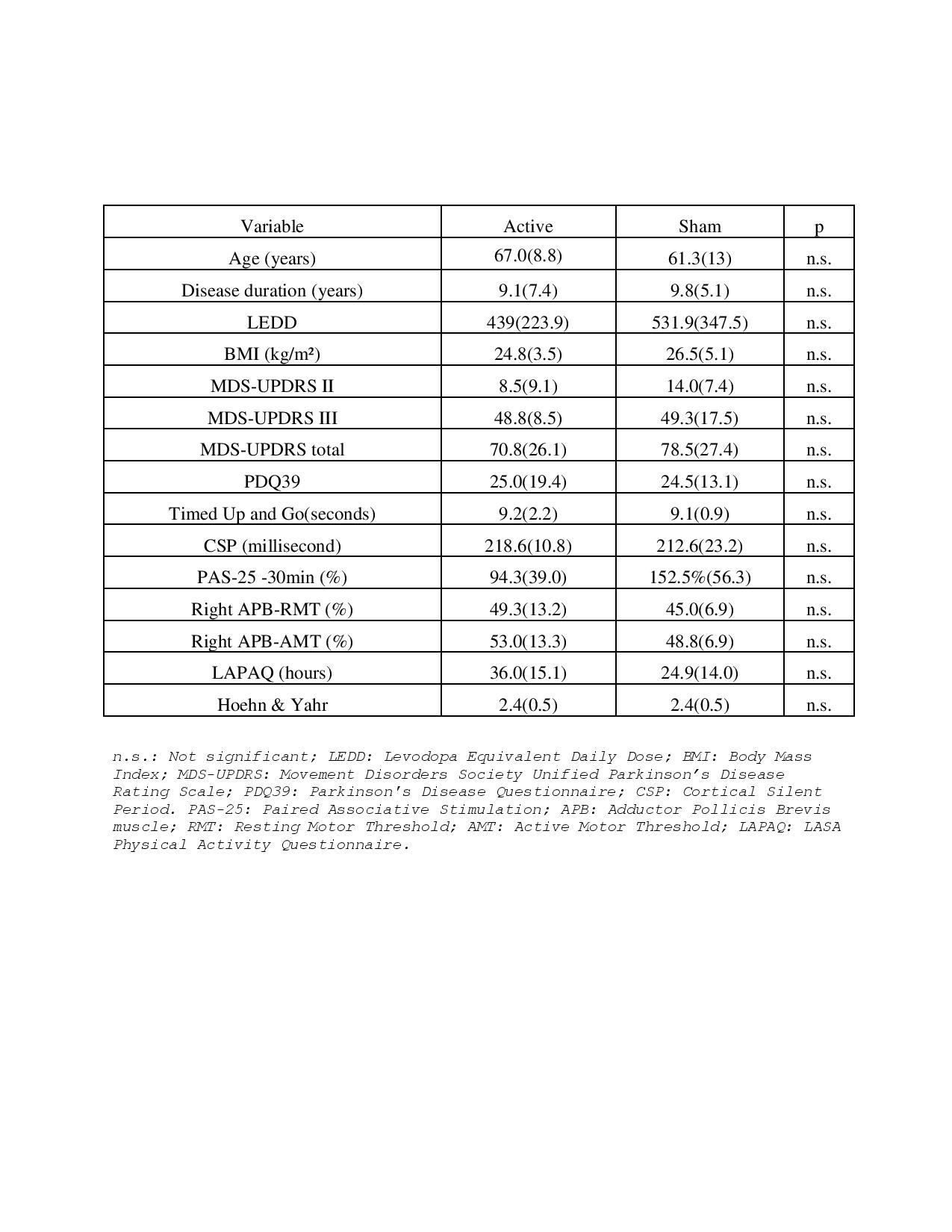Session Information
Date: Thursday, June 8, 2017
Session Title: Parkinson’s Disease: Clinical Trials, Pharmacology And Treatment
Session Time: 1:15pm-2:45pm
Location: Exhibit Hall C
Objective: To explore clinical and neuro-physiological outcomes of aerobic exercise combined with real Vs sham repetitive transcranial magnetic stimulation (rTMS) over motor cortex (M1) in PD.
Background: Recent studies have suggested that aerobic exercise might contribute to slowing down the deterioration of PD quality of and might preserve motor function (1). According to preliminary studies, TMS seems effective in in improving motor symptoms in PD (2). Therefore, combining TMS with aerobic exercise could provide synergistic effects with potential clinical applications.
Methods: We designed a randomized double-blind control study to explore the effects of a 2-week aerobic exercise program paired with real rTMS (experimental group) Vs sham rTMS (control group) over M1. Stimulation parameters are: 5HZ rTMS at 90% motor threshold (MT), 1200 pulses, over 3 areas of M1 (left and right hand and, bilateral lower extremities). Clinical outcomes are: MDS-UPDRS, Timed-up-and-go and quality of life PD questionnaire-39 (PDQ-39) at baseline and 1 month follow-up. Neurophysiological outcomes are: resting and active motor threshold (RMT,AMT), cortical silent period (CSP) and paired-associative stimulation preceded by peripheral nerve stimulation of 25 millisecond (PAS-25) measured at baseline and 1 month follow-up. All outcomes were obtained during ON time (1-3 hours post L-Dopa dosing).
Results: Baseline demographics, clinical characteristics and neurophysiology did not significantly differ between groups (Table 1). Eight patients were enrolled and completed all study visits. There were no serious adverse events. All procedures were well tolerated by all participants. In the control group, PDQ-39 score increased 2.25 (SD 8.5) points and in the experimental group decreased 10.25 (SD5.9) points (P=0.057, z=-1.83). In the control group; CSP decreased 18.5 (SD17.05) milliseconds and, in the experimental group increased 31.75(SD26.4) milliseconds (P=0.034, z=-2.12). No significant differences were found in the other outcomes.
Conclusions: Our study showed an improvement in PDQ-39 and a prolongation of CSP in the experimental group. As CSP is generally shortened in PD, this finding could reflect adequate restorative intra-cortical modulation in the rTMS group. A limitation of our study is the sample size preventing further analysis. Our preliminary results show that rTMS adjuvancy on aerobic exercise is a feasible and safe intervention.
References:
- Exercise Slows Quality-of-Life Decline in Parkinson’s, 19th International Congress of Parkinson’s Disease and Movement Disorders (MDS). Abstract LBA15. Presented June 16, 2015.
- Chou YH, Hickey PT, Sundman M, Song AW, Chen NK. Effects of repetitive transcranial magnetic stimulation on motor symptoms in Parkinson disease: a systematic review and meta-analysis. JAMA Neurol. 2015 Apr;72(4):432-40. doi: 10.1001/jamaneurol.2014.4380. Review. PubMed PMID: 25686212; PubMed Central PMCID: PMC4425190.
To cite this abstract in AMA style:
H. Migdadi, M. Biagioni, S. Agarwal, A. Cucca, P. Kumar, A. Quartarone, R. Rossi, M. Ghilardi, A. Di Rocco. Aerobic Exercise Combined with rTMS for Parkinson’s Disease: A Randomized Trial [abstract]. Mov Disord. 2017; 32 (suppl 2). https://www.mdsabstracts.org/abstract/aerobic-exercise-combined-with-rtms-for-parkinsons-disease-a-randomized-trial/. Accessed April 26, 2025.« Back to 2017 International Congress
MDS Abstracts - https://www.mdsabstracts.org/abstract/aerobic-exercise-combined-with-rtms-for-parkinsons-disease-a-randomized-trial/

